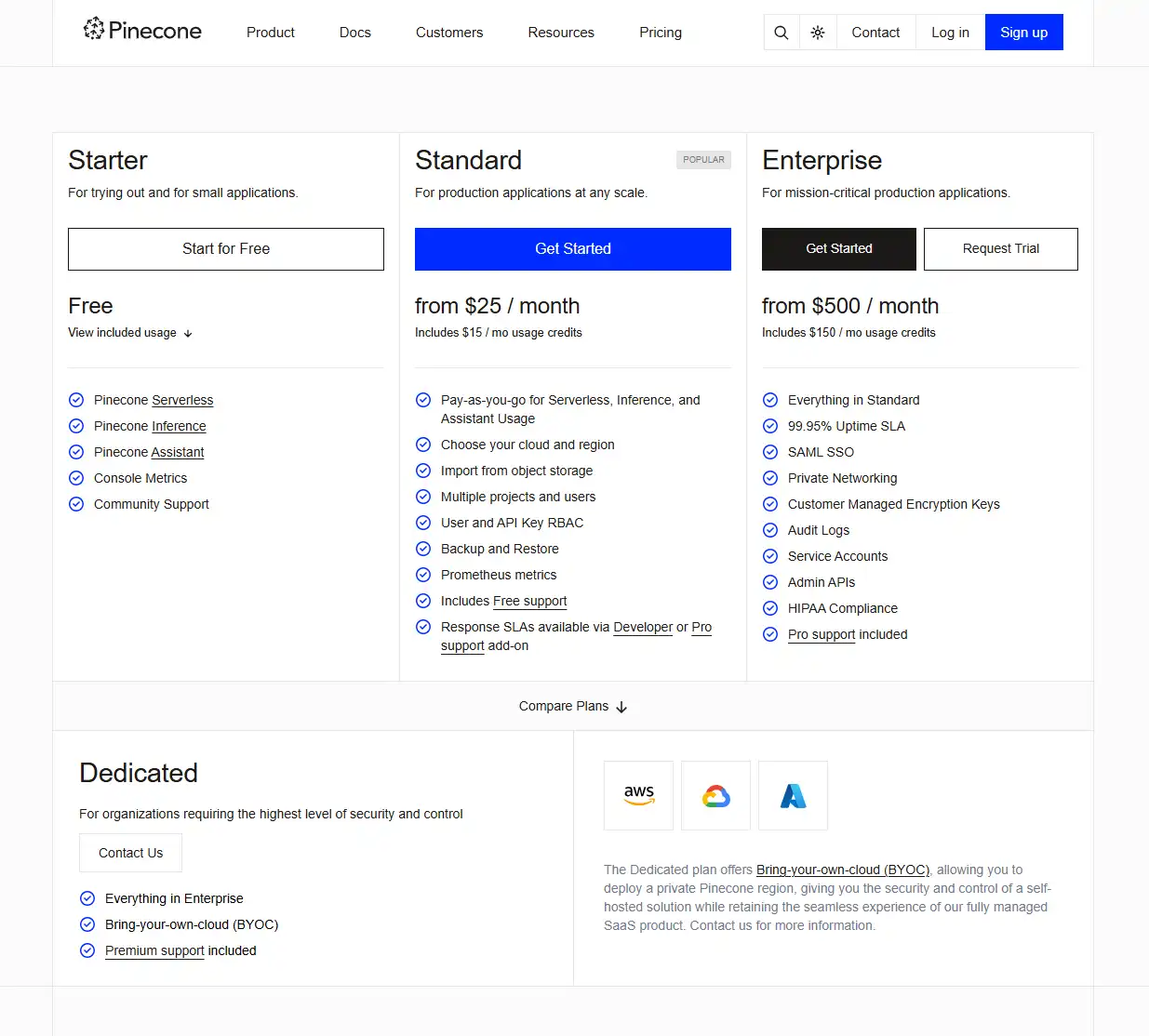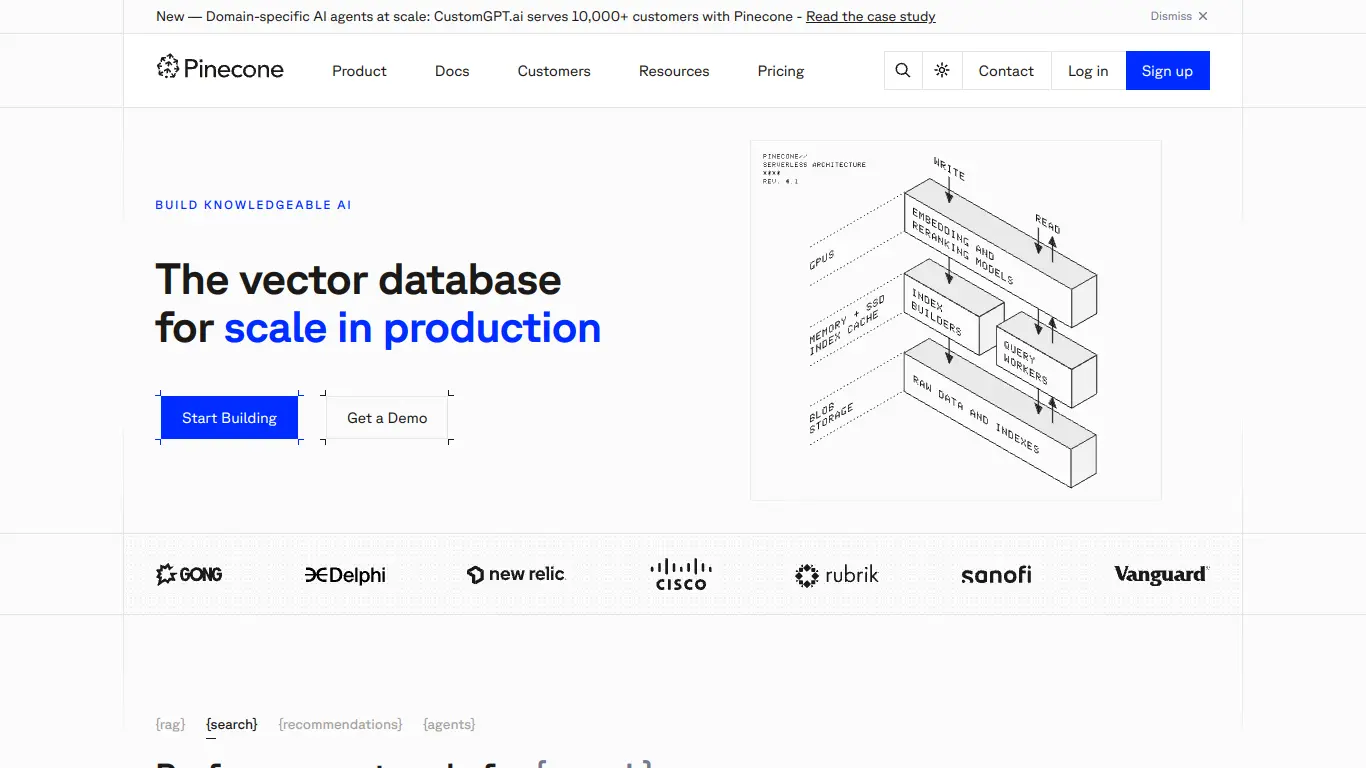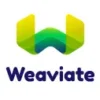Pinecone is a specialized vector database for AI applications that enables fast similarity search at scale with minimal operational overhead.
Introduction to Pinecone
Managing vector embeddings efficiently has become a critical challenge. Enter Pinecone – a specialized vector database designed to solve the complex problems of similarity search at scale. But what exactly makes Pinecone stand out in the increasingly crowded field of AI infrastructure tools?
What is Pinecone and its Purpose?
Pinecone is a vector database built specifically for machine learning applications that require similarity search. At its core, Pinecone enables developers and data scientists to store, search, and retrieve high-dimensional vector embeddings efficiently. These embeddings are numerical representations of data (text, images, audio, etc.) that capture semantic meaning in a way that traditional databases simply can’t handle.
The primary purpose of Pinecone is to make vector search scalable, fast, and easy to implement. When you transform data into vector embeddings using models like BERT, OpenAI embeddings, or other embedding techniques, you need a specialized database to query them effectively. Pinecone addresses this need by providing:
- Ultra-fast similarity search across billions of vectors
- Seamless scaling for production applications
- Simple API integration for developers
- Real-time updates to your vector data
Think of Pinecone as the bridge between your AI models and your applications. It’s the infrastructure that allows you to turn vector embeddings into practical, deployable features within your products.
Who is Pinecone Designed For?
Pinecone serves a diverse range of professionals working with AI and machine learning:
- Machine Learning Engineers: Looking to deploy vector search capabilities in production applications
- Data Scientists: Needing to explore semantic relationships in large datasets
- AI Application Developers: Building products that leverage similarity search
- Enterprise AI Teams: Scaling vector search across large organizations
- Researchers: Experimenting with new approaches to vector-based information retrieval
The platform is particularly valuable for teams building applications like:
- Semantic search engines
- Recommendation systems
- Content discovery platforms
- Fraud detection systems
- Image and video search
- Natural language processing applications
What unites Pinecone users is the need to solve similarity search problems efficiently at scale—whether they’re part of startups or enterprise organizations.
Getting Started with Pinecone: How to Use It
Getting started with Pinecone is surprisingly straightforward, especially considering the complexity of the problems it solves. Here’s a simplified workflow:
- Create an account: Visit Pinecone’s website and sign up for an account.
- Generate your API key: After registration, you’ll receive a unique API key to authenticate your requests.
- Create an index: Define your vector dimensions and distance metric (cosine, Euclidean, or dot product) based on your application’s needs.
- Upload your vectors: Transform your data into vectors using your preferred embedding model, then upload them to Pinecone with associated metadata.
- Query your index: Send vector queries to find the most similar items in your database.
Here’s a basic example using the Pinecone Python client:
import pinecone
# Initialize connection
pinecone.init(api_key="your-api-key", environment="your-environment")
# Create index
pinecone.create_index("example-index", dimension=768, metric="cosine")
# Connect to index
index = pinecone.Index("example-index")
# Upsert vectors
index.upsert([
("id1", [0.1, 0.2, ..., 0.7], {"category": "electronics"}),
("id2", [0.2, 0.3, ..., 0.8], {"category": "books"})
])
# Query
results = index.query(
vector=[0.15, 0.25, ..., 0.75],
top_k=5,
include_metadata=True
)
The integration is designed to be developer-friendly, with SDKs available for Python, Node.js, and other languages, plus comprehensive documentation on the Pinecone website.
Pinecone’s Key Features and Benefits
Core Functionalities of Pinecone
Pinecone’s feature set is focused on delivering exceptional vector search capabilities. Here are the core functionalities that set it apart:
1. High-Performance Vector Search
Pinecone’s architecture is optimized for Approximate Nearest Neighbor (ANN) search, allowing for sub-second queries across billions of vectors. This is achieved through sophisticated indexing techniques that balance accuracy and speed.
2. Advanced Filtering
Beyond simple vector similarity, Pinecone allows for complex metadata filtering. This means you can combine semantic search with traditional filtering operations, such as:
- Finding semantically similar products within a specific price range
- Discovering related content published within a particular timeframe
- Identifying similar users who match specific demographic criteria
3. Hybrid Search
Pinecone supports hybrid search capabilities, combining the power of vector similarity with keyword search for more precise results.
4. Serverless Architecture
The platform is fully managed, eliminating the need to provision servers, manage scaling, or handle infrastructure maintenance.
5. Real-Time Updates
Unlike some vector databases that require rebuilding indexes, Pinecone supports real-time updates, allowing you to continuously add, modify, or delete vectors without performance degradation.
6. Multiple Distance Metrics
Depending on your use case, you can choose from different similarity metrics:
- Cosine similarity (ideal for text embeddings)
- Euclidean distance (often used for image embeddings)
- Dot product (useful for certain recommendation systems)
7. Namespace Management
Pinecone allows you to organize vectors into namespaces, making it easier to manage different datasets within the same index.
Advantages of Using Pinecone
Pinecone offers several compelling advantages that explain its growing popularity among AI developers and teams:
1. Simplified Infrastructure Management 📈
As a fully managed service, Pinecone eliminates the complex infrastructure challenges traditionally associated with deploying vector search at scale.
2. Cost Efficiency 💰
By optimizing resource utilization automatically, Pinecone can be more cost-effective than building and maintaining custom vector search solutions.
3. Reduced Time-to-Market ⏱️
Teams can implement sophisticated vector search features in days rather than months, significantly accelerating development cycles.
4. Enterprise-Grade Security 🔒
Pinecone provides robust security features including:
- SOC 2 Type 2 compliance
- Data encryption at rest and in transit
- Private network connectivity options
- Role-based access control
5. Seamless Scalability 🚀
The platform automatically scales to handle growing data volumes and query loads without requiring manual intervention.
6. Production Readiness 🛠️
With 99.9% uptime SLAs and global availability, Pinecone provides the reliability needed for production applications.
7. Technical Support 👥
Dedicated support teams and comprehensive documentation help users solve problems quickly.
Main Use Cases and Applications
Pinecone’s versatility makes it suitable for a wide range of applications. Here are some of the most common use cases:
1. Semantic Search Systems
By leveraging vector embeddings, Pinecone powers search experiences that understand the meaning behind queries, not just keywords. This results in more relevant results for users searching through documents, products, or content.
2. Recommendation Engines
Pinecone enables personalized recommendations by finding items similar to those a user has previously engaged with, based on semantic similarity rather than just collaborative filtering.
3. Conversational AI and RAG (Retrieval Augmented Generation)
For chatbots and AI assistants, Pinecone serves as the retrieval component in RAG architectures, finding relevant context to ground large language model responses in factual information.
4. Image and Video Search
Using visual embeddings, Pinecone enables searching for visually similar images or video frames – useful for content moderation, asset management, and creative applications.
5. Anomaly Detection
By identifying vectors that are distant from clusters of normal data, Pinecone helps power systems that detect unusual patterns in financial transactions, network traffic, or user behavior.
6. De-duplication
Finding near-identical content across large datasets helps companies identify duplicate records, redundant content, or plagiarized material.
7. Personalization Engines
By storing user preference vectors, Pinecone enables real-time personalization across websites, apps, and marketing campaigns.
Exploring Pinecone’s Platform and Interface
User Interface and User Experience
Pinecone’s platform strikes a balance between simplicity and power, making it accessible to users with varying levels of technical expertise.
Dashboard Overview
The main dashboard provides a clear view of your indexes, including:
- Index status and health metrics
- Vector counts and storage utilization
- Query performance statistics
- Recent API activity
Index Management Interface
Creating and managing indexes is straightforward through both the web interface and API. The UI guides users through important configuration decisions:
- Dimension size selection
- Similarity metric choice
- Pod type and size options
- Replica configuration for high availability
Monitoring and Analytics
Pinecone provides real-time metrics that help teams monitor:
- Query latency (p50, p95, p99 percentiles)
- Throughput rates
- Error rates
- Resource utilization
The visual presentation of these metrics makes it easy to identify trends and potential issues before they impact users.
Documentation Integration
One of Pinecone’s UX strengths is the seamless integration of documentation throughout the interface. Contextual help and explanations appear alongside technical options, reducing the learning curve for new users.
Platform Accessibility
Pinecone prioritizes accessibility across multiple dimensions:
Developer Experience
The platform offers:
- RESTful API with consistent design
- Client libraries for popular languages (Python, Node.js, Java)
- Comprehensive code examples
- Interactive API documentation with Swagger UI
Integration Ecosystem
Pinecone integrates smoothly with the broader AI/ML ecosystem:
- Direct connections to popular embedding models like OpenAI
- LangChain integration for RAG workflows
- Compatibility with major ML frameworks
- Streamlined data pipelines with tools like Weights & Biases
Learning Resources
To help users get the most from the platform, Pinecone provides:
- Detailed tutorials and quickstart guides
- Interactive notebooks
- Webinars and video walkthroughs
- Community forums for peer support
Cloud Compatibility
Pinecone’s service runs across major cloud providers, giving users flexibility in where they deploy:
- AWS regions
- GCP regions
- Azure support (in development)
Pinecone Pricing and Plans
Subscription Options
Pinecone offers a tiered pricing model that scales with usage, making it accessible to both startups and enterprise organizations.

The free tier is substantial enough for proof-of-concept projects and learning, while the paid tiers enable scaling to production workloads.
Pinecone Reviews and User Feedback
Pros and Cons of Pinecone
Based on user reviews and industry feedback, here’s a balanced assessment of Pinecone’s strengths and limitations:
Pros:
- Performance Excellence ⚡
Users consistently praise Pinecone’s query speed, even at large scale. The platform delivers on its promise of millisecond response times across millions of vectors. - Ease of Implementation 🛠️
The simple API and clear documentation make it quick to integrate Pinecone into existing workflows, with many users reporting deployment in days rather than weeks. - Reliability 🏆
Enterprise users appreciate the consistent uptime and performance stability, noting fewer issues compared to self-hosted alternatives. - Scalability 📈
The ability to seamlessly handle growing data volumes without performance degradation is frequently highlighted as a key advantage. - Customer Support 👥
Many reviews mention responsive and knowledgeable support, particularly on the enterprise tier.
Cons:
- Pricing Complexity 💰
Some users find the pricing model complex and difficult to predict, especially as scale increases. - Limited Customization ⚙️
For highly specialized use cases, the managed nature of Pinecone can limit low-level optimizations that might be possible with open-source alternatives. - Learning Curve for Vector Concepts 📚
While not specific to Pinecone, some teams report challenges in transitioning to vector-thinking from traditional database approaches. - Feature Release Pace ⏱️
A few users note that new features sometimes arrive slower than in some competitive offerings. - Regional Availability 🌎
Some international users wish for more deployment regions to reduce latency in specific geographies.
User Testimonials and Opinions
Feedback from real Pinecone users provides insight into how the platform performs in production environments:
“We migrated from our custom vector search solution to Pinecone and immediately saw a 30% improvement in query speed while dramatically reducing our maintenance overhead. The ROI was clear within the first month.”
— Engineering Director at a mid-sized e-commerce company
“Pinecone was the missing piece in our RAG implementation. Before, we struggled with retrieval quality and speed. After implementing Pinecone, our LLM responses became noticeably more accurate and consistent.”
— AI Research Lead at a financial services firm
“The biggest advantage for our team was how quickly we could get up and running. We went from concept to production in two weeks, which would have been impossible if we had to build the vector infrastructure ourselves.”
— CTO at an AI startup
“While the initial setup was smooth, we did hit some scaling challenges when we crossed 10 million vectors. However, Pinecone’s support team helped us optimize our configuration, and we’re now running smoothly at 50 million vectors.”
— Senior ML Engineer in healthcare
“We evaluated several vector databases, and Pinecone won on simplicity and performance. The trade-off was higher cost compared to self-hosted options, but the engineering time saved more than justified the expense.”
— VP of Data Science at a media company
Pinecone Company and Background Information
About the Company Behind Pinecone
Pinecone Systems Inc. has emerged as a significant player in the AI infrastructure space, focusing specifically on vector database technology.
Founding and Leadership
Pinecone was founded in 2019 by Edo Liberty, who serves as the company’s CEO. Before founding Pinecone, Liberty was the director of research at Yahoo and later Amazon AI, where he worked extensively on machine learning infrastructure and vector search technologies. His academic background includes a Ph.D. in computer science with a focus on high-dimensional data algorithms.
The leadership team combines expertise from both academic research and industry experience at companies like Amazon, Google, and Meta, bringing deep knowledge of machine learning systems and infrastructure.
Funding and Growth
Pinecone has attracted significant venture capital investment, reflecting confidence in both the technology and the growing market for vector databases:
- Series A: $10 million (January 2021)
- Series B: $28 million (March 2022)
- Series C: $100 million (April 2023)
This funding has supported rapid growth in both the platform’s capabilities and the company’s market presence. Pinecone’s valuation reportedly reached $750 million after its Series C round, demonstrating the strategic importance investors place on vector database technology.
Company Culture and Mission
Pinecone describes its mission as “making vector search accessible to every developer,” with an emphasis on simplifying complex machine learning infrastructure. The company maintains a strong research orientation, regularly contributing to academic publications and open-source projects in the vector search space.
The team operates with a remote-first approach, with employees distributed across North America, Europe, and Israel, allowing them to draw talent from a global pool of machine learning and database experts.
Pinecone Alternatives and Competitors
Top Pinecone Alternatives in the Market
Several noteworthy alternatives to Pinecone exist in the vector database space, each with different strengths and trade-offs:
- Weaviate (weaviate.io)
- Open-source vector database with GraphQL API
- Can be self-hosted or used as a managed service
- Strong focus on semantic search and knowledge graphs
- Milvus (milvus.io)
- Open-source vector database platform
- Highly scalable architecture
- Extensive indexing algorithm options
- Available as self-hosted or cloud service (Zilliz Cloud)
- Qdrant (qdrant.tech)
- Open-source vector similarity search engine
- Focuses on extended filtering capabilities
- Available self-hosted or as a cloud service
- Chroma (trychroma.com)
- Open-source embedding database
- Particularly popular for RAG applications
- Lightweight and easy to integrate
- Redis with RediSearch (redis.io)
- Vector search capabilities within the popular Redis database
- Good option for teams already using Redis
- Combines vector search with other Redis capabilities
- MongoDB Atlas Vector Search (mongodb.com)
- Vector search integrated into MongoDB
- Appealing for existing MongoDB users
- Combines document and vector capabilities
- Elasticsearch with k-NN (elastic.co)
- Vector search extensions for Elasticsearch
- Strong for hybrid text + vector search
- Benefits from Elasticsearch’s mature ecosystem
Pinecone vs. Competitors: A Comparative Analysis
When comparing Pinecone to alternatives, several factors stand out:
| Feature | Pinecone | Open-Source Alternatives | Other Managed Services |
|---|---|---|---|
| Ease of Setup | Very high (fully managed) | Moderate to complex (requires deployment expertise) | Varies (generally simpler than self-hosted) |
| Scalability | Excellent (billions of vectors) | Good, but requires careful configuration | Varies by provider |
| Query Performance | Excellent (optimized infrastructure) | Good, depends on deployment quality | Varies by provider |
| Pricing Model | Usage-based, can get expensive at scale | Infrastructure costs only | Usually usage-based |
| Customization | Limited to API parameters | Highly customizable (algorithm selection, etc.) | Varies by provider |
| Integration | Simple REST API, client libraries | Depends on solution, often similar | Similar API-based approaches |
| Maintenance Overhead | Minimal (fully managed) | Significant (updates, scaling, monitoring) | Low to moderate |
Key Differentiators:
- Pinecone’s Strengths:
- Fastest path to production deployment
- Consistent performance at scale
- Lower operational overhead
- Regular feature updates without migration effort
- Open-Source Alternatives’ Strengths:
- Greater control over infrastructure
- Potentially lower costs at large scale
- No vendor lock-in
- Ability to customize algorithms and parameters
- Specialized Competitors’ Strengths:
- MongoDB/Elasticsearch: Better for hybrid workloads with existing data
- Weaviate: Advanced for knowledge graph applications
- Chroma: Simplicity for smaller-scale applications
The optimal choice depends on specific requirements around scale, existing infrastructure, technical expertise, and budget constraints.
Pinecone Website Traffic and Analytics
Website Visits Over Time
Pinecone has experienced substantial growth in web traffic, reflecting increasing interest in vector database technologies:
📊 Estimated Monthly Traffic Trend (2022-2023)
- Q1 2022: ~50,000-75,000 visits/month
- Q2 2022: ~80,000-100,000 visits/month
- Q3 2022: ~120,000-150,000 visits/month
- Q4 2022: ~180,000-220,000 visits/month
- Q1 2023: ~250,000-300,000 visits/month
- Q2 2023: ~350,000-400,000 visits/month
- Q3 2023: ~450,000-500,000 visits/month
This growth pattern coincides with the broader explosion of interest in generative AI and vector-based applications, particularly following the mainstream attention on large language models.
Geographical Distribution of Users
Pinecone’s user base spans globally, with particular concentration in technology hubs:
🌎 Top Regions by Traffic
- United States (~40%)
- Europe (~25%)
- UK
- Germany
- France
- Asia (~20%)
- India
- Singapore
- Japan
- Canada (~5%)
- Australia (~3%)
- Other regions (~7%)
This distribution aligns with major AI research and development centers globally, with the strongest adoption in North America and Europe.
Main Traffic Sources
Understanding how users discover Pinecone provides insight into its growth strategy and community presence:
🔍 Traffic Source Breakdown
- Organic Search: ~45% (dominated by technical search terms like “vector database” and “similarity search”)
- Direct Traffic: ~25% (indicating strong brand recognition)
- Referrals: ~15% (including GitHub, ML forums, and partner sites)
- Social Media: ~10% (primarily LinkedIn, Twitter, and technical communities)
- Paid Channels: ~5% (targeted advertising on technical platforms)
The high proportion of organic and direct traffic suggests that Pinecone has established strong awareness within the machine learning and AI developer communities.
Frequently Asked Questions about Pinecone (FAQs)
General Questions about Pinecone
Q: What exactly is a vector database, and why would I need one?
A: A vector database is specialized for storing and searching vector embeddings – numerical representations of data that capture semantic meaning. Traditional databases struggle with “similarity” queries, while vector databases excel at finding the most similar items quickly. You’d need one if you’re building applications involving semantic search, recommendations, anomaly detection, or other AI features requiring similarity matching.
Q: How does Pinecone compare to just using nearest neighbor search in my existing database?
A: While some traditional databases now offer basic vector search capabilities, Pinecone is purpose-built for this use case, offering orders of magnitude better performance at scale. General-purpose databases typically struggle with the “curse of dimensionality” when handling high-dimensional vectors across millions of records.
Q: Is Pinecone suitable for small projects or just enterprise applications?
A: Pinecone works well for projects of all sizes. The free tier supports up to 100,000 vectors, which is sufficient for many small to medium applications. The service scales seamlessly as your needs grow, making it appropriate for everything from prototypes to large-scale enterprise deployments.
Q: Does Pinecone work with any embedding model?
A: Yes, Pinecone is model-agnostic and works with embeddings from any source as long as they’re consistent in dimension size. You can use embeddings from OpenAI, Hugging Face, custom models, or any other embedding provider.
Feature Specific Questions
Q: What’s the maximum vector dimension Pinecone supports?
A: Pinecone supports vector dimensions up to 20,000, though most common embedding models use dimensions between 384 and 1,536. Higher dimensions generally provide more representation capacity but require more storage and can impact performance.
Q: How does metadata filtering work in Pinecone?
A: Each vector in Pinecone can have associated metadata (JSON objects). When querying, you can apply filters to this metadata to narrow results to specific categories, date ranges, numerical ranges, or other criteria. This combines the power of vector similarity with traditional filtering.
Q: Can I update vectors once they’re in Pinecone?
A: Yes, Pinecone supports real-time updates. You can add, modify, or delete vectors without rebuilding your index, and changes are reflected immediately in search results. This is particularly valuable for dynamic applications where data changes frequently.
Q: What distance metrics does Pinecone support?
A: Pinecone supports three distance metrics:
- Cosine similarity (best for text embeddings)
- Euclidean distance (often used for image embeddings)
- Dot product (useful for certain recommendation algorithms)
The appropriate metric depends on your specific embedding model and use case.
Pricing and Subscription FAQs
Q: How is Pinecone pricing calculated?
A: Pinecone pricing is based on several factors:
- Number of vectors stored
- Vector dimensions
- Pod type (which affects performance)
- Number of replicas (for high availability)
- Query volume
The exact pricing formula can be found on their website and changes occasionally as new features are added.
Q: Is there a free tier available?
A: Yes, Pinecone offers a free tier that includes:
- 1 index
- Up to 100,000 vectors
- Limited queries per month
- Standard support through documentation
This is sufficient for development, testing, and small applications.
Q: Can I estimate my costs before committing?
A: Pinecone provides a pricing calculator on their website that allows you to estimate costs based on your expected usage patterns. For large deployments, they also offer custom quotes.
Q: Is there a minimum commitment period?
A: Pinecone operates on a pay-as-you-go model without long-term commitments for standard plans. Enterprise plans may have different terms based on specific requirements.
Support and Help FAQs
Q: What kind of support does Pinecone offer?
A: Support options vary by plan:
- Free tier: Community support and documentation
- Standard plans: Email support with defined response times
- Enterprise plans: Dedicated support channels, faster response times, and optional technical account management
Q: Where can I learn how to use Pinecone effectively?
A: Pinecone offers extensive learning resources:
- Comprehensive documentation
- Tutorials and quickstart guides
- Code examples in multiple languages
- Webinars and video walkthroughs
- Community forum for peer support
Q: Does Pinecone offer professional services for implementation?
A: For enterprise customers, Pinecone offers professional services to assist with architecture design, optimization, and implementation. These services can accelerate deployment and ensure best practices are followed.
Q: How can I report issues or request features?
A: Pinecone maintains multiple channels for feedback:
- Support tickets (for paying customers)
- GitHub repositories (for client libraries)
- Community forums
- Direct feedback to account representatives (enterprise)
Conclusion: Is Pinecone Worth It?
Summary of Pinecone’s Strengths and Weaknesses
After thoroughly examining Pinecone’s capabilities, pricing, and user feedback, we can summarize its key strengths and limitations:
Strengths:
- Exceptional Performance ⚡
Pinecone delivers consistently fast query performance even at massive scale, with optimized infrastructure that would be challenging to replicate independently. - Developer Experience 👨💻
The straightforward API, clear documentation, and managed infrastructure dramatically reduce the complexity of implementing vector search capabilities. - Reliability and Scalability 📈
As a purpose-built, managed service, Pinecone handles the complex challenges of scaling vector search while maintaining consistent performance. - Time-to-Market Advantage ⏱️
Organizations can deploy sophisticated similarity search features in days rather than the months it might take to build custom solutions. - Integration Ecosystem 🔄
Strong integrations with popular embedding models, ML frameworks, and LangChain make Pinecone easily incorporable into existing workflows.
Weaknesses:
- Cost at Scale 💰
For very large deployments, Pinecone’s pricing can become significant, potentially exceeding the infrastructure costs of self-hosted alternatives. - Limited Customization ⚙️
As a managed service, Pinecone offers fewer options for low-level customization compared to open-source alternatives. - Vendor Lock-in Concerns 🔒
Migrating away from Pinecone can be challenging once you’ve built systems around its specific API and capabilities. - Regional Coverage 🌎
While improving, Pinecone’s regional availability may not satisfy organizations with specific geographic deployment requirements.
Final Recommendation and Verdict
For Startups and Small Teams:
Pinecone offers exceptional value through its free tier and straightforward scaling path. The ability to deploy sophisticated vector search without infrastructure expertise is particularly valuable for resource-constrained teams. For most startups building AI-powered applications, Pinecone represents the fastest path to production with minimal operational overhead.
For Mid-size Organizations:
The decision becomes more nuanced for mid-size companies. Pinecone’s managed approach eliminates significant engineering investment while providing enterprise-grade performance. Unless your team has specific vector database expertise or unusual customization requirements, Pinecone likely offers the best balance of performance, reliability, and time-to-value.
For Enterprise Organizations:
Large enterprises should evaluate Pinecone alongside alternatives based on specific scaling requirements, existing infrastructure, and in-house expertise. While Pinecone’s enterprise tier offers the necessary security and support features, organizations with massive vector datasets might find cost advantages in custom solutions or open-source alternatives—though these come with significantly higher operational responsibilities.
Overall Verdict:
Pinecone has earned its position as a leading vector database by delivering exceptional performance with minimal complexity. For the majority of organizations building applications with vector embeddings, Pinecone represents the optimal choice, particularly when considering the total cost of ownership (including engineering time and operational overhead).
The platform is especially valuable for:
- Teams without specialized vector database expertise
- Applications requiring rapid time-to-market
- Use cases demanding reliable, consistent performance
- Organizations focusing engineering resources on core product differentiation rather than infrastructure
As the vector database market continues to evolve, Pinecone’s focus on developer experience and performance optimization positions it well to remain a top choice for organizations building the next generation of AI-powered applications.


















